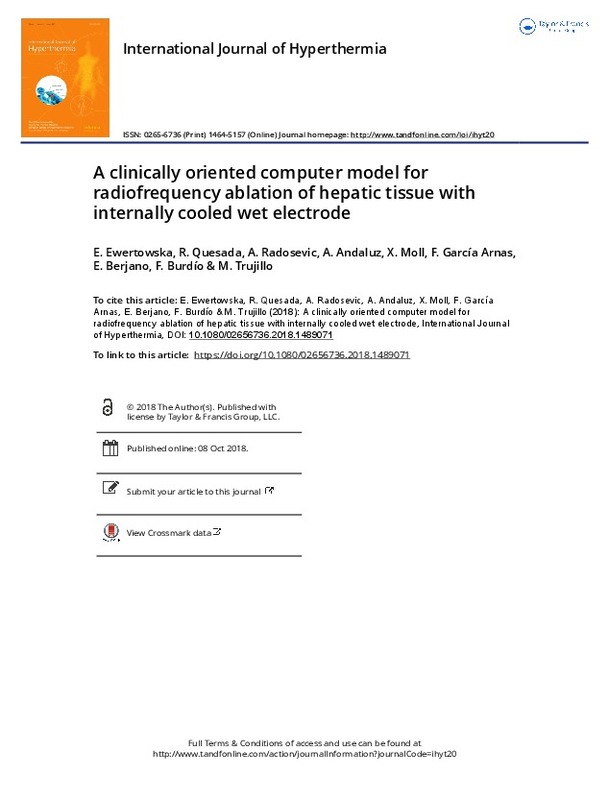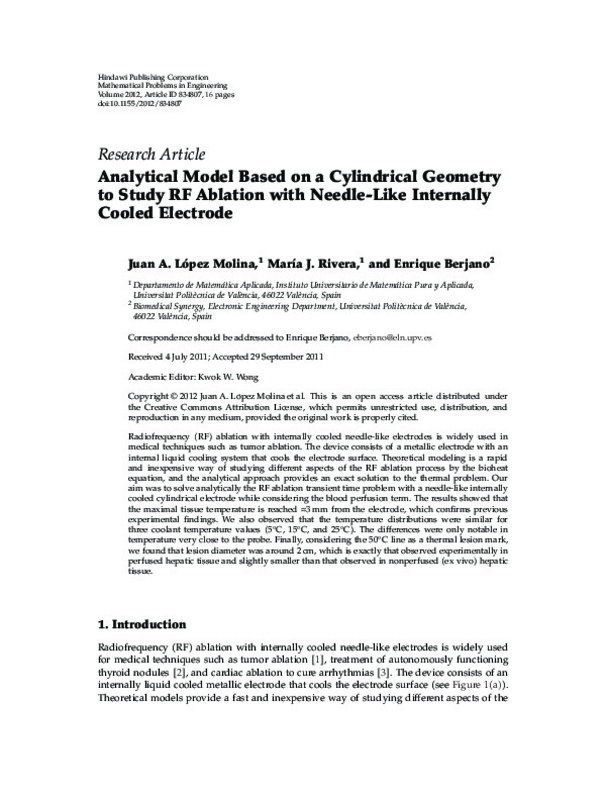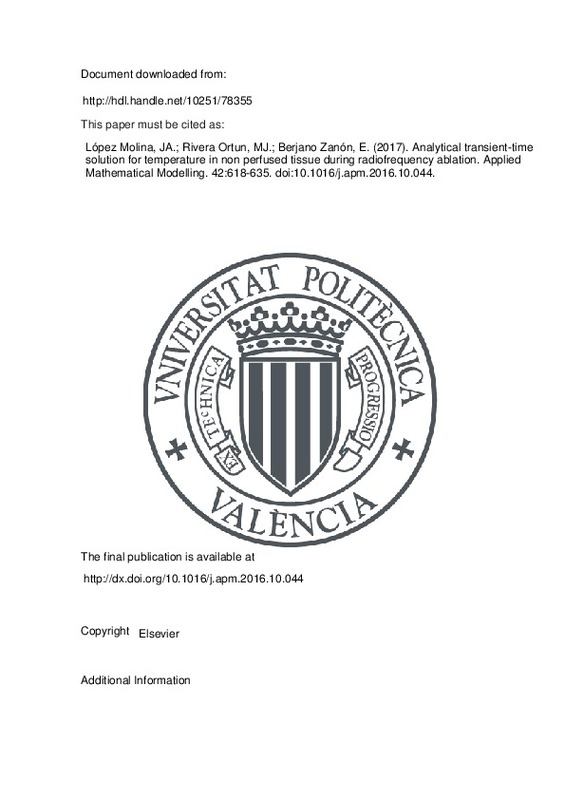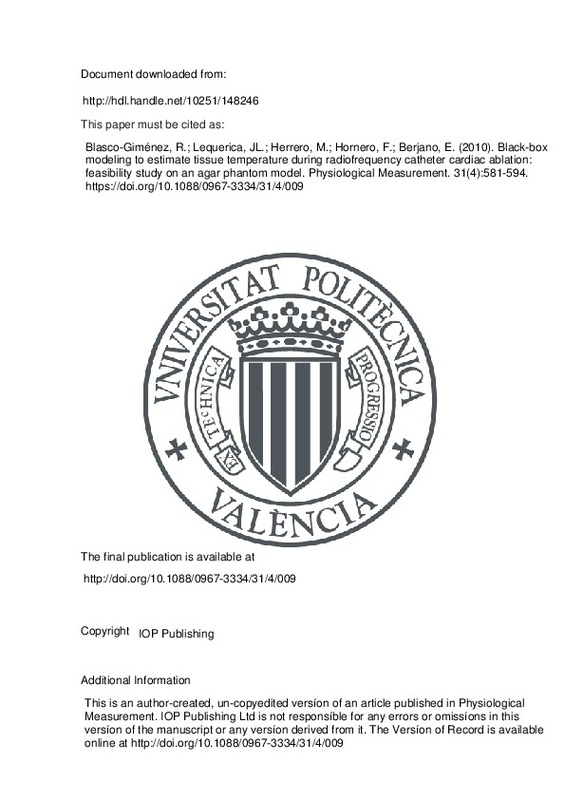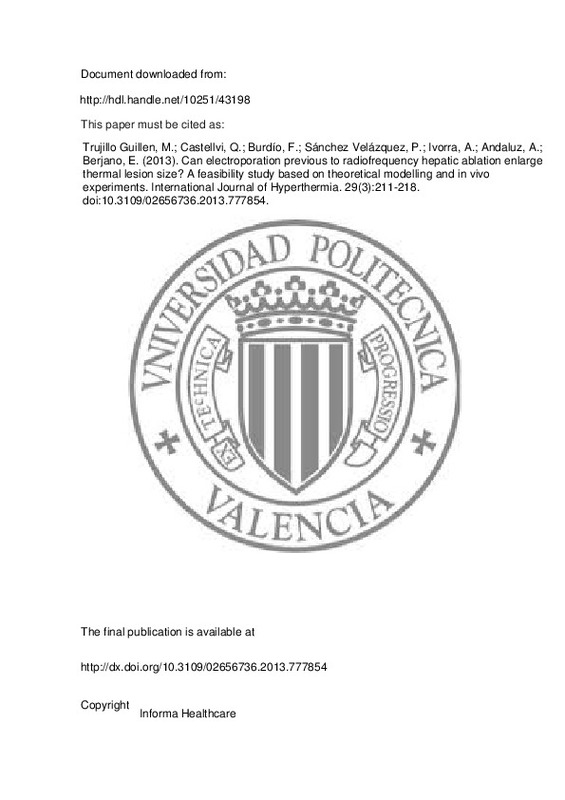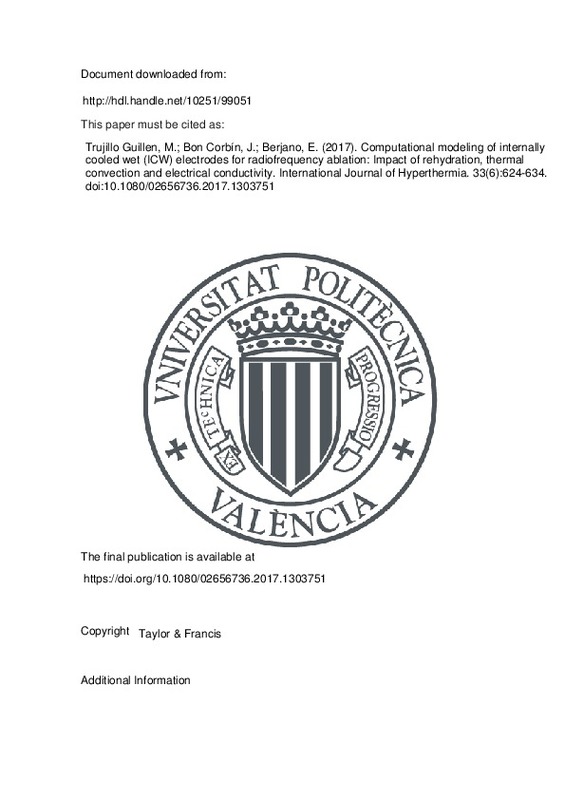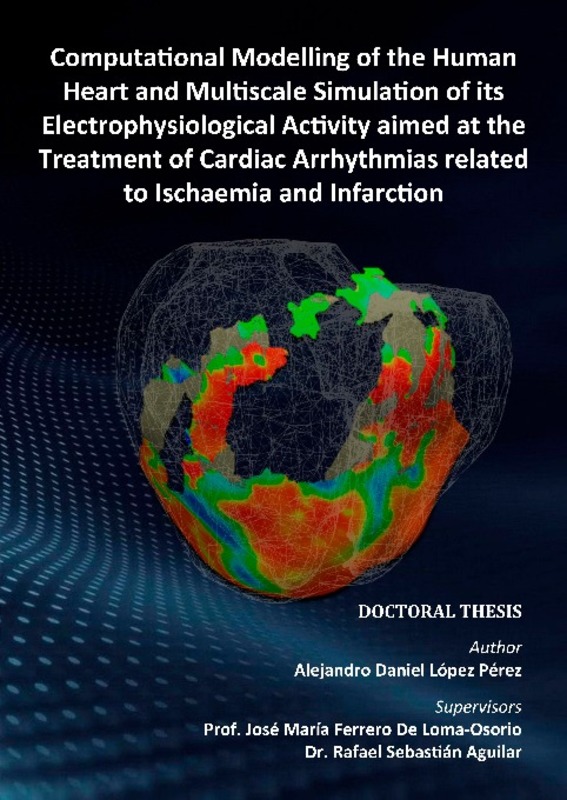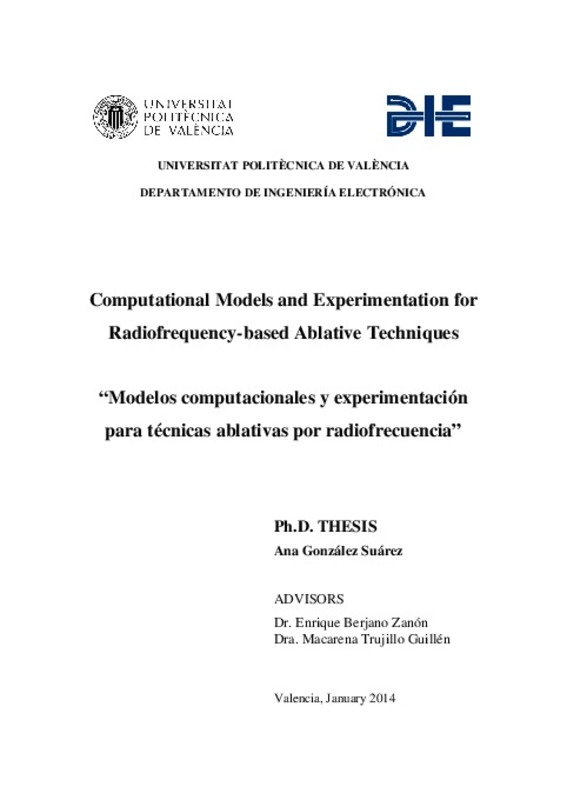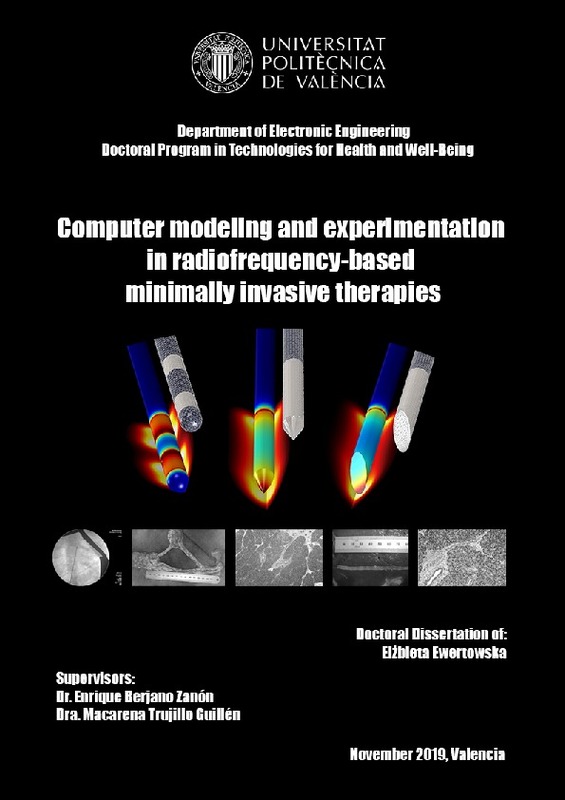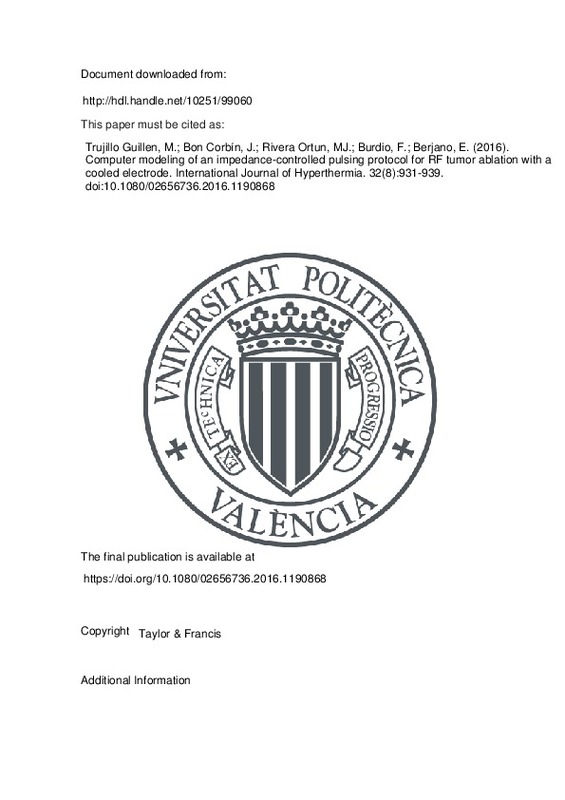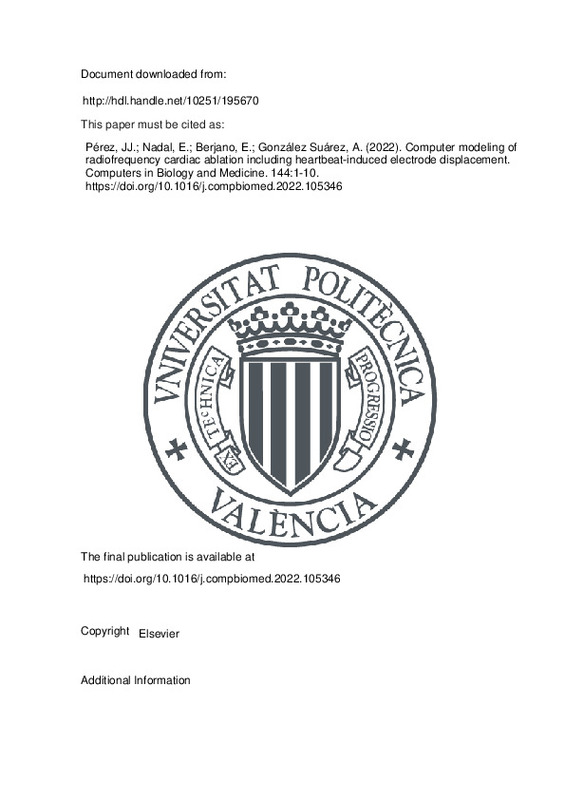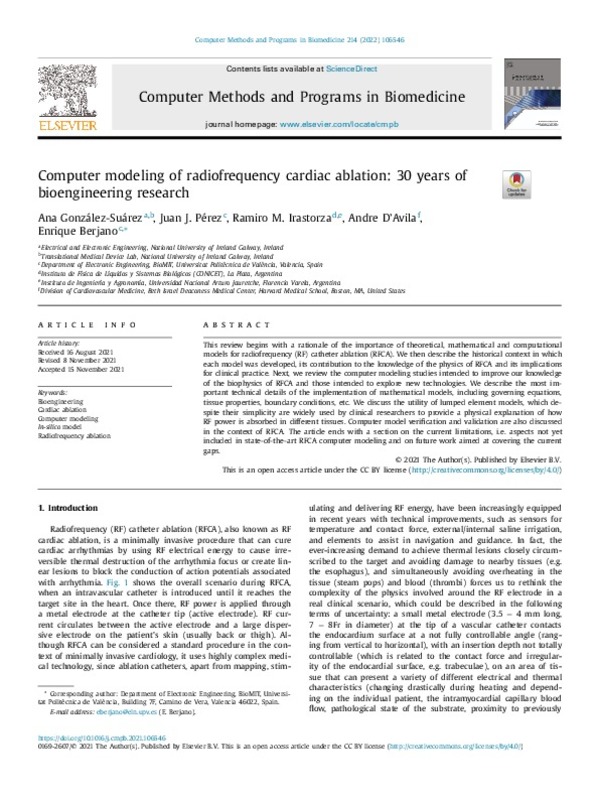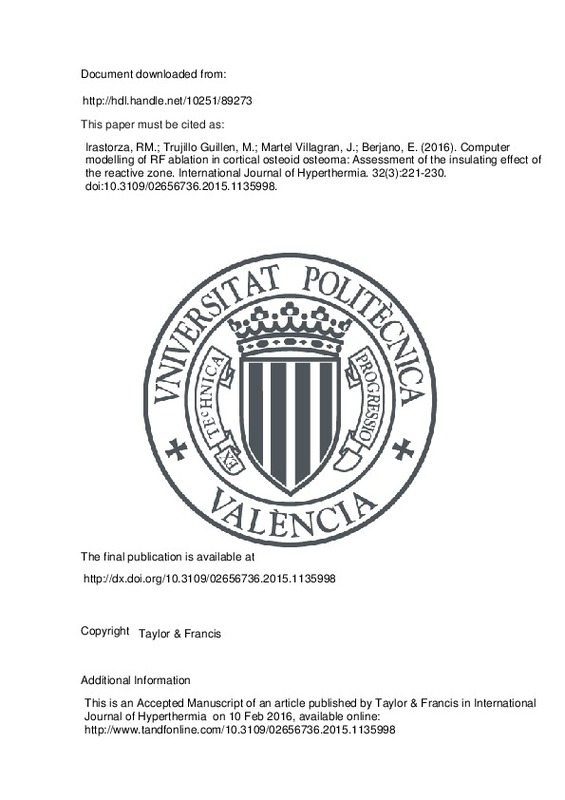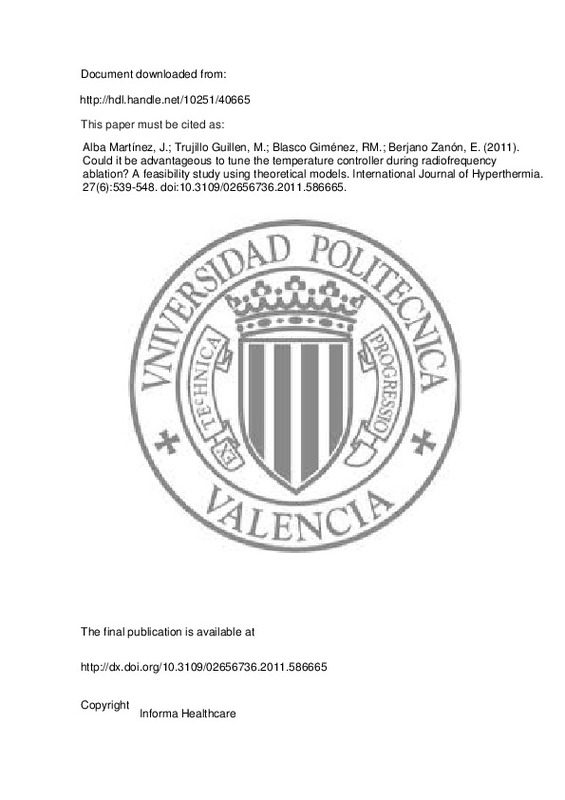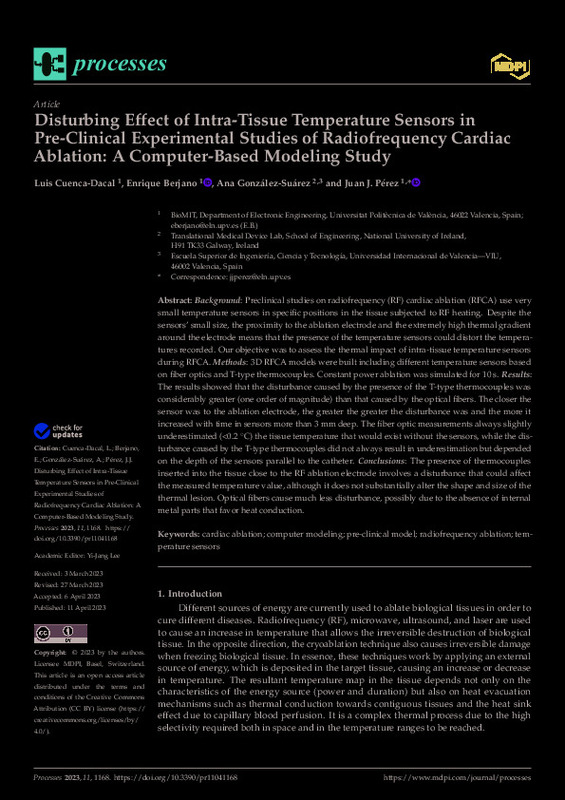

Listar por palabra clave "Radiofrequency ablation"
RiuNet: Repositorio Institucional de la Universidad Politécnica de Valencia
- RiuNet repositorio UPV
- :
- Listar por palabra clave
JavaScript is disabled for your browser. Some features of this site may not work without it.
Buscar en RiuNet
Listar
Mi cuenta
Ayuda RiuNet
Admin. UPV
Listar por palabra clave "Radiofrequency ablation"
Mostrando ítems 1-20 de 47
-
Ewertowska, Elzbieta; Quesada-Diez, Rita; Radosevic, A.; Andaluz, Anna; Moll, Xavier; García Arnás, F.; Berjano, Enrique; Burdío Pinilla, Fernando; Trujillo Guillen, Macarena (Taylor & Francis, 2019)[EN] Purpose: To improve the computer modelling of radiofrequency ablation (RFA) by internally cooled wet (ICW) electrodes with added clinically oriented features. Methods: An improved RFA computer model by ICW electrode ...
-
Burdío, Fernando; Grande, Luis; Berjano, Enrique; Martinez-Serrano, Maria; Poves, Ignasi; Burdío, José M.; Navarro, Ana; Güemes, Antonio (Elsevier, 2010-12)[EN] The objective of this study was to evaluate the clinical feasibility of a new technique for liver resection based on a radiofrequency-assisted (485 kHz) device that has shown high performance in the animal setting ...
-
López Molina, Juan Antonio; Rivera Ortun, María José; Berjano Zanón, Enrique (Hindawi Publishing Corporation, 2012)Radiofrequency (RF) ablation with internally cooled needle-like electrodes is widely used in medical techniques such as tumor ablation. The device consists of a metallic electrode with an internal liquid cooling system ...
-
López Molina, Juan Antonio; Rivera Ortun, María José; Berjano Zanón, Enrique (Elsevier, 2016-10-26)[EN] Radiofrequency ablation (RFA) with internally cooled needle-like electrodes is a technique widely used to destroy cancer cells. In a previous study we obtained the analytical solution of the biological heat equation ...
-
Blasco-Giménez, Ramón; Lequerica, Juan L.; Herrero, María; Hornero, Fernando; Berjano, Enrique (IOP Publishing, 2010-04)[EN] The aim of this work was to study linear deterministic models to predict tissue temperature during radiofrequency cardiac ablation (RFCA) by measuring magnitudes such as electrode temperature, power and impedance ...
-
Trujillo Guillen, Macarena; Castellvi, Quim; Burdío, Fernando; Sánchez Velázquez, Patricia; Ivorra, Antoni; Andaluz, Anna; Berjano, Enrique (Informa Healthcare, 2013-05)Purpose: The aim of this study was to assess the feasibility of a hybrid ablative technique based on applying electroporation (EP) pulses just before conducting radiofrequency ablation (RFA). The rationale was that the ...
-
Fatieieva, Yuliia; Almendárez, Pedro; Romero-Méndez, Ricardo; Berjano, Enrique; Trujillo Guillen, Macarena (Cosmos Scholars Publishing House, 2014-09)[EN] During high-temperature energy-based therapies such as radiofrequency ablation (RFA) the target tissue reaches temperatures around 100ºC, which causes tissue dehydration by water vaporization. In order to be as ...
-
Trujillo Guillen, Macarena; Bon Corbín, José; Berjano, Enrique (Taylor & Francis, 2017)[EN] Purpose: (1) To analyse rehydration, thermal convection and increased electrical conductivity as the three phenomena which distinguish the performance of internally cooled electrodes (IC) and internally cooled wet ...
-
López Pérez, Alejandro Daniel (Universitat Politècnica de València, 2019-09-02)[ES] Las enfermedades cardiovasculares constituyen la principal causa de morbilidad y mortalidad a nivel mundial, causando en torno a 18 millones de muertes cada año. De entre ellas, la más común es la enfermedad isquémica ...
-
González Suárez, Ana (Universitat Politècnica de València, 2014-03-14)Las técnicas ablativas basadas en energía por radiofrecuencia (RF) se emplean con el fin de lograr un calentamiento seguro y localizado en el tejido biológico. En los últimos años ha habido un rápido crecimiento en el ...
-
Arenas Puig, Francisco Javier; Pérez Martínez, Juan José; Trujillo Guillen, Macarena; Berjano Zanón, Enrique (BioMed Central, 2014-12-12)Background Externally irrigated radiofrequency (RF) electrodes have been widely used to thermally ablate tumors in surface tissue and to thermally coagulate the transection plane during a surgical resection. As far as ...
-
Ewertowska, Elzbieta (Universitat Politècnica de València, 2020-01-07)[ES] La ablación por radiofrecuencia (RF) se ha convertido en una técnica ablativa importante, ampliamente utilizada en el área de las terapias mínimamente invasivas de la medicina moderna. El avance en el campo de las ...
-
Pérez, Juan J; Ewertowska, Elzbieta; Berjano, Enrique (John Wiley & Sons, 2020-11)[EN] Background and Objectives Radiofrequency (RF)-induced ablation can be carried out inside ducts and vessels by simultaneously dragging a bipolar catheter while applying RF power. Our objective was to characterize the ...
-
Trujillo Guillen, Macarena; Bon Corbín, José; Rivera Ortun, María José; Burdio, Fernando; Berjano, Enrique (Taylor & Francis, 2016)[EN] Purpose: To develop computer models to mimic the impedance-controlled pulsing protocol implemented in radiofrequency (RF) generators used for clinical practice of radiofrequency ablation (RFA), and to assess the ...
-
Pérez, Juan J; Nadal, Enrique; Berjano, Enrique; González Suárez, Ana (Elsevier, 2022-05)[EN] Background: The state of the art in computer modeling of radiofrequency catheter ablation (RFCA) only considers a static situation, i.e. it ignores ablation electrode displacements induced by tissue movement due to ...
-
González-Suárez, Ana; Pérez, Juan J; Irastorza, Ramiro M.; D Avila, Andre; Berjano, Enrique (Elsevier, 2022-02)[EN] This review begins with a rationale of the importance of theoretical, mathematical and computational models for radiofrequency (RF) catheter ablation (RFCA). We then describe the historical context in which each model ...
-
Irastorza, Ramiro M.; Trujillo Guillen, Macarena; Martel Villagran, Jose; Berjano, Enrique (Taylor & Francis, 2016-02-10)Purpose: The aim was to study by computer simulations the insulating role of the reactive zone surrounding a cortical osteoid osteoma (OO) in terms of electrical and thermal performance during radiofrequency ablation ...
-
Alba Martínez, José; Trujillo Guillen, Macarena; Blasco Giménez, Ramón Manuel; Berjano Zanón, Enrique (Informa Healthcare, 2011-09)Purpose: To assess whether tailoring the Kp and Ki values of a proportional-integral (PI) controller during radiofrequency (RF) cardiac ablation could be advantageous from the point of view of the dynamic behaviour of the ...
-
Burdio, Fernando; Berjano, Enrique; Milian, Olga; Grande, Luis; Poves, Ignasi; Silva, Claudio; De la Fuente, Maria Dolors; Mojal, Sergi (Elsevier, 2013)[EN] Purpose: To track the saline during infusion with a 15 G needle into healthy pig livers at high and low infusion rates for 300 s. Methods: In each experiment, the needle was inserted into a single lobe of the liver ...
-
Cuenca-Dacal, Luis; Berjano, Enrique; González-Suárez, Ana; Pérez, Juan J (MDPI AG, 2023-04-11)[EN] Background: Preclinical studies on radiofrequency (RF) cardiac ablation (RFCA) use very small temperature sensors in specific positions in the tissue subjected to RF heating. Despite the sensors' small size, the ...
Mostrando ítems 1-20 de 47

Universitat Politècnica de València. Unidad de Documentación Científica de la Biblioteca (+34) 96 387 70 85 · RiuNet@bib.upv.es


